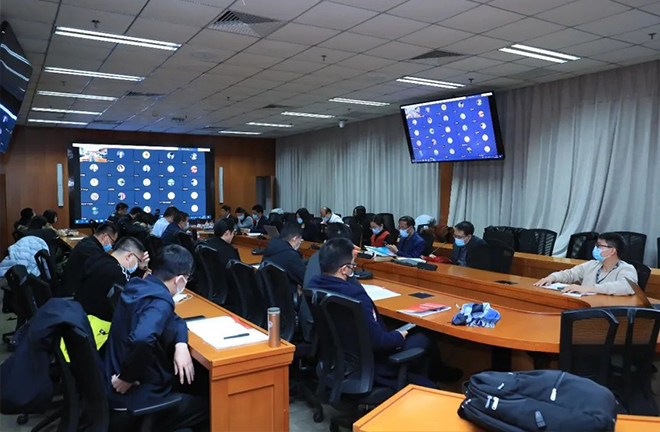Seminar explores social risk governance

The Fifth China Social Risk Governance Forum in Beijing on Dec. 11 Photo: THU
The Fifth China Social Risk Governance Forum was held by the Center for Social Risk Assessment in China at Tsinghua University in Beijing on Dec. 11. Attendees shed light on capacity building regarding the identification, forewarning, prevention, and control of various emerging risks, contributing wisdom to the modernization of social governance.
Complex situation
China will usher in a new stage of development during the 14th Five-Year Plan (2021–25) period, said Guo Yong, deputy secretary of the Party Committee of Tsinghua University. In front of the new development stage and new situation, it is necessary to be ever ready to protect against potential dangers, resolutely implement a holistic approach to national security, and uphold the organic unity of political security and the people’s security. Guo also suggested putting national interests first, thus ensuring safe development throughout all fields and the whole process in national development. Efforts should be made to deal with the opportunities and challenges brought about by “internal and international imperatives,” ensure traditional and non-traditional security, guard the bottom line of secure development, and maintain social stability and national security.
The major risk points at home and abroad are mutually interconnected and easily agitated, featuring risks that are transmitted from overseas to domestic, extended from online to offline, upgraded from single to comprehensive, and spread from the economic to social sectors. Chen Zhimin, deputy director of the Committee on Social and Legal Affairs at the Chinese People’s Political Consultative Conference, noted that against intricate and severe domestic and international situations, scholars engaged in the modernization of China’s social governance and risk prevention should not only focus upon domestic affairs, but also have an international vision, constantly elevating the capacity and level of China’s social governance.
Talking about the world economy amidst the COVID-19 pandemic, Zhou Li, former vice minister of the International Department of the Central Committee of the CPC, said that the contradiction between supply and demand in today’s world economy has exacerbated global inflation, the shortage economy has become a new normal, and the international energy market under the pandemic has continued its volatility. All these are weakening the momentum of economic recovery. Whether the industrial chain and supply chain can maintain basic stability is not only an issue China faces, but also a common challenge for the whole world.
Urban security
As new forms of life services empower economic and social development, they are also accompanied by new social risks, said Peng Zongchao, secretary of the Party Committee from the School of Public Policy and Management at Tsinghua University. He suggested introducing social risk governance to guarantee a more sustainable and secure development for the new forms of life services. Government is expected to proactively lead industry supervision, platform enterprises to actively build risk identification and advanced intervention systems, and society to participate in joint governance to address social stability risks underlying these new forms.
Urban communities are the main body bearing compound disasters, the primary-level governance unit of the national disaster system, and the important endogenous force of every city, said Zhu Zhengwei, a professor from the School of Public Policy and Management at Xi’an Jiaotong University. In responding to composite disasters, the resilience governance of urban communities should ensure both development and security and improve community resilience planning.
Shan Guangnai, a research fellow from the Institute of Sociology at the Chinese Academy of Social Sciences, mentioned two major risks that call for great attention. First of all, China is confronted with the three big pressures of contracted demand, supply shocks, and weakening expectations. Governmental departments need to strengthen supervision and response to exposed systemic financial risks represented by the capital chain rupture of some large enterprises. Second, changes in social mentality call for concern. In the context of economic slowdown, particular attention should be placed on individuals’ sense of relative deprivation caused by the mismatch between social ability and social expectation so as to prevent the secondary fluctuation of public opinion and social conflicts.
Global climate change has also brought forth new risks. Regarding the situation of diverse disaster-inducing factors and the complex environment in China, Zhang Qiang, a professor from the School of Social Development and Public Policy at Beijing Normal University, suggested having multiple parties involved in the top-level design of catastrophe response in order to systematically cope with uncertain risks.
According to Jiang Xiaoping, secretary of the Party Committee of the School of Public Administration at Sichuan University, urban security construction needs to diagnose pain spots of social security governance, solidify the defensive line from the source, adhere to problem orientations and system thinking, and respond to the needs of the people. In doing so, we aim at making a “panoramic” social governance prevention and control system, establishing an “interactive” comprehensive social governance mechanism, and improving social risk coordination of the “litigation source” type. It is advisable to work to explore “people-centered” methods for urban social security governance, create a “diverse” social psychological counseling mechanism, and bring about the “agile” urban social security governance.
Nowadays, urban grid management has covered all cities in China, said Fan Bo, deputy dean of the School of International and Public Affairs at Shanghai Jiao Tong University. The risk prevention and emergency management of urban disasters can be superimposed on the existing urban grid management, realizing source prevention and a linkage network with different weights and risk levels in various regions and easing the risks that exist in mega cities. Building a cross-departmental, cross-tiered, and cross-field emergency mobilization system enables more resilient and more flexible emergency rescue.
Edited by YANG LANLAN
